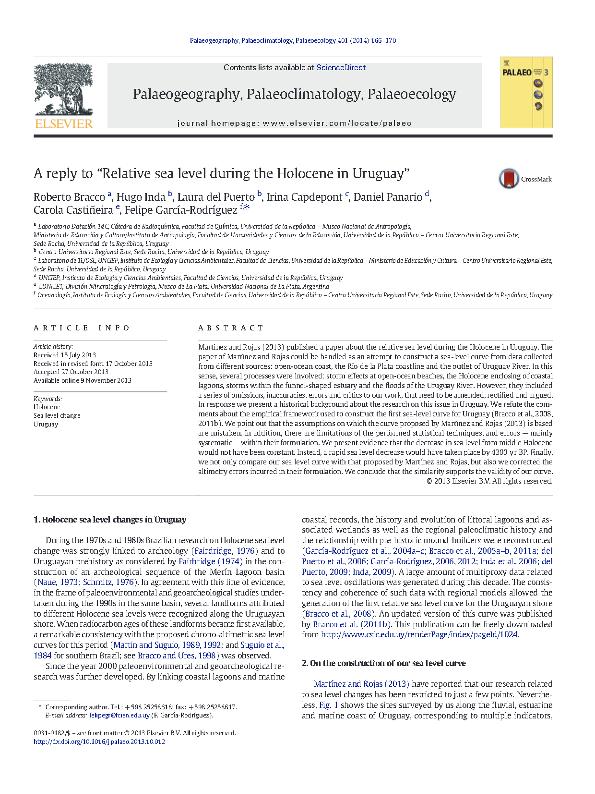Mostrar el registro sencillo del ítem
dc.contributor.author
Bracco, Roberto
dc.contributor.author
Inda, Hugo
dc.contributor.author
del Puerto, Laura

dc.contributor.author
Capdepont, Irina
dc.contributor.author
Panario, Daniel

dc.contributor.author
Castiñeira Latorre, Carola

dc.contributor.author
Garcia Rodriguez, Felipe

dc.date.available
2018-01-08T16:48:01Z
dc.date.issued
2014-05
dc.identifier.citation
Garcia Rodriguez, Felipe; Bracco, Roberto; del Puerto, Laura; Panario, Daniel; Castiñeira Latorre, Carola; Capdepont, Irina; et al.; A reply to “Relative sea level during the Holocene in Uruguay”; Elsevier Science; Palaeogeography, Palaeoclimatology, Palaeoecology; 401; 5-2014; 166-170
dc.identifier.issn
0031-0182
dc.identifier.uri
http://hdl.handle.net/11336/32516
dc.description.abstract
Martínez and Rojas (2013) published a paper about the relative sea level during the Holocene in Uruguay. The paper of Martínez and Rojas could be handled as an attempt to construct a sea-level curve from data collected from different sources: open-ocean coast, the Río de la Plata coastline and the outlet of Uruguay River. In this sense, several processes were involved: storm effects at open-ocean beaches, the Holocene enclosing of coastal lagoons, storms within the funnel-shaped estuary and the floods of the Uruguay River. However, they included a series of omissions, inaccuracies, errors and critics to our work, that need to be amended, rectified and argued. In response we present a historical background about the research on this issue in Uruguay. We refute the comments about the empirical framework used to construct the first sea-level curve for Uruguay (Bracco et al., 2008, 2011b). We point out that the assumptions on which the curve proposed by Martínez and Rojas (2013) is based are mistaken. In addition, there are limitations of the performed statistical techniques, and errors — mainly systematic — within their formulation. We present evidence that the decrease in sea level from middle Holocene would not have been constant. Instead, a rapid sea level decrease would have taken place by 4300 yr BP. Finally, we not only compare our sea level curve with that proposed by Martínez and Rojas, but also we corrected the altimetry errors incurred in their formulation. We conclude that the similarity supports the validity of our curve.
dc.format
application/pdf
dc.language.iso
eng
dc.publisher
Elsevier Science

dc.rights
info:eu-repo/semantics/openAccess
dc.rights.uri
https://creativecommons.org/licenses/by-nc-sa/2.5/ar/
dc.subject
Holocene
dc.subject
Sea Level Change
dc.subject
Uruguay
dc.subject.classification
Historia

dc.subject.classification
Historia y Arqueología

dc.subject.classification
HUMANIDADES

dc.title
A reply to “Relative sea level during the Holocene in Uruguay”
dc.type
info:eu-repo/semantics/article
dc.type
info:ar-repo/semantics/artículo
dc.type
info:eu-repo/semantics/publishedVersion
dc.date.updated
2017-12-26T14:30:29Z
dc.journal.volume
401
dc.journal.pagination
166-170
dc.journal.pais
Países Bajos

dc.journal.ciudad
Amsterdam
dc.description.fil
Fil: Bracco, Roberto. Universidad de la República; Uruguay
dc.description.fil
Fil: Inda, Hugo. Universidad de la República; Uruguay
dc.description.fil
Fil: del Puerto, Laura. Universidad de la República; Uruguay
dc.description.fil
Fil: Capdepont, Irina. Universidad de la República; Uruguay
dc.description.fil
Fil: Panario, Daniel. Universidad de la República; Uruguay
dc.description.fil
Fil: Castiñeira Latorre, Carola. Universidad Nacional de la Plata. Facultad de Ciencias Naturales y Museo. División Mineralogía y Petrología; Argentina. Consejo Nacional de Investigaciones Científicas y Técnicas; Argentina
dc.description.fil
Fil: Garcia Rodriguez, Felipe. Universidad de la República; Uruguay
dc.journal.title
Palaeogeography, Palaeoclimatology, Palaeoecology

dc.relation.alternativeid
info:eu-repo/semantics/altIdentifier/doi/http://dx.doi.org/10.1016/j.palaeo.2013.10.012
dc.relation.alternativeid
info:eu-repo/semantics/altIdentifier/url/http://www.sciencedirect.com/science/article/pii/S0031018213004689
Archivos asociados
